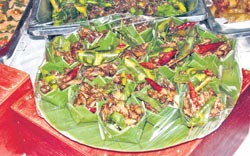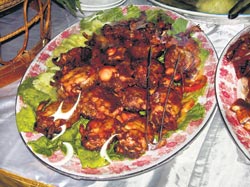
Going hungry at a food festivalFrom fried cockroaches to snake meat, Sanath Weerasuriya finds the exotic cuisine of Laos too raw for his taste Food culture from country to country is different in style, preparation and presentation. Some love it raw, some hot and spicy and others prefer it cooked. Indochina – Laos, Vietnam and Cambodia, is where you experience the likes of giant crabs, black shrimps, huge tiger prawns, a variety of pork preparations, raw chicken, half done duck, deep fried grasshoppers, roasted full frogs and fried cockroaches with a full glass of snake blood with spices and sauces to supplement it.
While Sri Lanka is making an effort towards conserving turtles, they are a delicacy at top food festivals and gala dinners in Laos, Thailand and Vietnam. I had a taste of the ‘eating culture’ of Laos at the ‘baci pakuan’ on the second day of the Ecotourism Forum at Vientiane, the capital of Lao PDR. The gala dinner at the opening of the ASEAN Ecotourism Forum at the Don Chang Palace Hotel almost had me on an empty stomach right throughout. The very first dish that caught my eye was one of fried cockroaches with chillies. Action stations all around boasted Lao cuisine, Thai delights, Vietnamese dishes, Chinese and Cambodian specialities and Korean food. Half done ducks, deep fried grasshoppers, roasted full frogs, fried insects, raw meat and fish, snails and worms seemed to be the most sought after dishes that night. The saying ‘When in Rome, do as the Romans do” came to mind but I was suspicious of every dish. I wasn’t even certain whether the fried rice was sans raw meat. Even at wayside restaurants, popular in Bangkok and Vientiane, half cooked and raw food items seemed to be popular among many foreigners. Snake meat with vegetables, worms and baby turtles are the delicacies in specialized restaurants, targeting upmarket clientele.
So what do the ordinary people eat? Sticky rice and duck, pork or fish straight from the great Mekong River are their usual fare. Seafood is popular at any restaurant or hotel even though Laos is a landlocked country. The famous Thai soup Tom Yam, which is seafood based is a hot favourite in Laos too. Keng no may, a bamboo shoot soup, or keng het bot made with mushrooms are two other favourite soups in Laos. For travellers from Bangkok, the striking difference between their food and Lao cuisine is the use of sticky, or glutinous rice (klao niaw) at every meal. Sitting down to a bowl of chopped raw meat, a chicken’s head, and a salad made of shrub leaves, and sticky rice interspersed with rounds of fiery home-made rice whisky is not the normal traveller’s idea of a mouth-watering exotic meal. But the occasional visitor to Laos is unlikely to experience such distinctively Lao food that favours raw food rather than cooked. This preference tells a lot about Laos culture: For instance, the proximity of most parts of Laos to the forest where food is still hunted or gathered in the provinces. While the Lao use their fingers to eat sticky rice (the consistency of the rice leaves no other option), they would never use their fingers, as the Siamese and Indians traditionally do, to eat white rice. Neither, do they use chopsticks like their Chinese and Vietnamese neighbours. Chopsticks are reserved for noodles. For white rice, the Lao use spoons. Along with klao niaw there is another essential ingredient in a Lao meal, one that the Lao tend to use as an ethnic marker. This is pa daek, a pungent fermented fish sauce. On the back verandah of every Lao peasant’s house you will find an earthenware jar of pa daek. And although books and tourist brochures often refer to Laos as the ‘Land of a million elephants’, ordinary Lao are more likely to call it the ‘land of khao niaw and pa daek’. The second distinctive dish of the Lao is laap. It is made with fish, chicken, duck, pork, beef, buffalo or with game. The meat and innards are finely chopped and spiced with onion chillie and other herbs such as mint. The Lao prefer laap seua, or "Tiger laap", that is raw chopped meat, but most often you will be served laap of cooked meat, especially in restaurants. A lovely regional dish is the Or lam from Luang Prabang. This is about as close as the Lao gets to something like European stew. Lemon grass, dried buffalo meat and skin, chillies and eggplant along with some pa daek are its basic ingredients, but its distinctive feature is the addition of crisp-fried pork skin and sweet basil. There are many fish preparations in Laos, but one, unhappily, has disappeared from the table. Pa boek , a large fish which was once found in the Mekong River is now a virtually extinct species due to over fishing and ecological changes in the Mekong River. |
|| Front
Page | News | Editorial | Columns | Sports | Plus | Financial
Times | International | Mirror | TV
Times | Funday
Times || |
| |
Copyright
2007 Wijeya
Newspapers Ltd.Colombo. Sri Lanka. |

